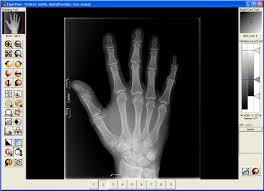One of the dangers of X-rays is the intense radiation that has been linked to cancers and diseases after much exposure. The invention of digital X-ray machines has minimized the amount of radiation that the patient comes in contact with, and digitizing the process also improves the quality of the prints and saves money.
How digital X-rays work
Beginning with the first X-ray in 1865, the traditional imaging process was lengthy and inefficient due to the printing, drying, and development of images. Digital X-rays work because of photon radiation, which happens because of the rapid acceleration or deceleration of charged particles. When a high voltage is added, electrons gain kinetic acceleration and are shot onto a metallic panel target. The panel converts the unabsorbed photons to light, which is then converted to an electrical signal with photodiodes, CCD, or CMOS imaging sensors. Finally, the signal is converted into a digital signal for image processing. Digital X-rays differ from the analog method mainly because digital images are immediately available, thanks to modern electronics and computing.

Digital X-ray of a patient's hand. Image via gatewayxray.com.
History behind the digital X-ray
During the mid-1980s, Robert Street of Palo Alto, CA, invented the first digital X-ray. Today digital X-rays can be found all over the country in different hospitals and medical centers. In fact, Street's discovery makes up over half of the mammography machines in the United States that are accurately detecting breast cancer and saving the lives of many women.
For more information
Digital X-ray machines are improving radiology offices across the nation and keeping patients healthier at a lower cost. For further interest, check out Mouser's Medical Applications page. Here you can find an interactive diagram behind the digital X-ray process, the parts that make up the intricate system and how to purchase pieces and parts. Mouser includes an analog-to-digital converter, a processor, a touch screen controller, and more pieces for digital X-ray imaging.
By Emily Bahr
Advertisement
Learn more about Electronic Products MagazineMouser Electronics





